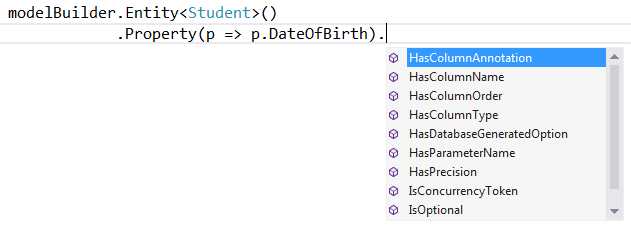标签:first nbsp standard let log iso 不能 sre .net
原文:http://www.entityframeworktutorial.net/code-first/configure-property-mappings-using-fluent-api.aspx
本节,我们将学习如何使用Fluent API配置实体类的属性。 我们将使用我们学校app的Student和Standard域类:
public class Student { public Student() { } public int StudentKey { get; set; } public string StudentName { get; set; } public DateTime DateOfBirth { get; set; } public byte[] Photo { get; set; } public decimal Height { get; set; } public float Weight { get; set; } public Standard Standard { get; set; } } public class Standard { public Standard() { } public int StandardKey { get; set; } public string StandardName { get; set; } public ICollection<Student> Students { get; set; } }
配置主键和复合主键
上面的域类,没有按照主键的Code-First约定,因为它们没有Id或{Class Name} + Id属性。
因此,你可以使用Fluent API使用EntityTypeConfiguration的HasKey()方法配置key属性,如下所示。 记住modelBuilder.Entity <TEntity>()返回EntityTypeConfiguration对象。
public class SchoolContext: DbContext { public SchoolDBContext(): base() { } public DbSet<Student> Students { get; set; } public DbSet<Standard> Standards { get; set; } protected override void OnModelCreating(DbModelBuilder modelBuilder) { //Configure primary key modelBuilder.Entity<Student>().HasKey<int>(s => s.StudentKey); modelBuilder.Entity<Standard>().HasKey<int>(s => s.StandardKey); //Configure composite primary key modelBuilder.Entity<Student>().HasKey<int>(s => new { s.StudentKey, s.StudentName }); } }
配置列名、列类型和排序
默认Code-First约定为名属性创建一个同名的列名、顺序和数据类型的列。 你可以覆盖此约定,如下所示:
public class SchoolContext: DbContext { public SchoolDBContext(): base() { } public DbSet<Student> Students { get; set; } public DbSet<Standard> Standards { get; set; } protected override void OnModelCreating(DbModelBuilder modelBuilder) { //Configure Column modelBuilder.Entity<Student>() .Property(p => p.DateOfBirth) .HasColumnName("DoB") .HasColumnOrder(3) .HasColumnType("datetime2"); } }
如上例所示,我们使用Property()方法为实体的属性配置任何东西。
在这里,我们使用HasColumnName来更改DateOfBirth属性的列名。 此外,我们调用HasColumnOrder和HasColumnType来更改列的顺序和数据类型。
modelBuilder.Entity <TEntity>().Property(expression)允许您使用不同的方法配置特定属性,如下所示:

为属性配置Null或Not Null列
Code-First将为原始数据类型属性创建NotNull列,因为原始数据类型不能为空,除非使用?符号或Nullable <T>。
使用IsOptional方法为属性创建一个可空的列。
以同样的方式,使用IsRequired方法创建一个NotNull列。
namespace CodeFirst_FluentAPI_Tutorials { public class SchoolContext: DbContext { public SchoolDBContext(): base() { } public DbSet<Student> Students { get; set; } public DbSet<Standard> Standards { get; set; } protected override void OnModelCreating(DbModelBuilder modelBuilder) { //Configure Null Column modelBuilder.Entity<Student>() .Property(p => p.Heigth) .IsOptional(); //Configure NotNull Column modelBuilder.Entity<Student>() .Property(p => p.Weight) .IsRequired(); } } }
配置列大小
Code-First将设置列的数据类型的最大大小。 您可以覆盖此约定,如下所示:
namespace CodeFirst_FluentAPI_Tutorials { public class SchoolContext: DbContext { public SchoolDBContext(): base() { } public DbSet<Student> Students { get; set; } public DbSet<Standard> Standards { get; set; } protected override void OnModelCreating(DbModelBuilder modelBuilder) { //Set StudentName column size to 50 modelBuilder.Entity<Student>() .Property(p => p.StudentName) .HasMaxLength(50); //Set StudentName column size to 50 and change datatype to nchar //IsFixedLength() change datatype from nvarchar to nchar modelBuilder.Entity<Student>() .Property(p => p.StudentName) .HasMaxLength(50).IsFixedLength(); //Set size decimal(2,2) modelBuilder.Entity<Student>() .Property(p => p.Height) .HasPrecision(2, 2); } } }
如上例所示,我们使用HasMaxLength方法设置列的大小。
IsFixedLength方法将nvarchar转换为nchar类型。
以同样的方式,HasPrecision方法改变了十进制列的精度。
配置并发列
你可以使用ConcurrencyToken方法将属性配置为并发列,如下所示:
namespace CodeFirst_FluentAPI_Tutorials { public class SchoolContext: DbContext { public SchoolDBContext(): base() { } public DbSet<Student> Students { get; set; } public DbSet<Standard> Standards { get; set; } protected override void OnModelCreating(DbModelBuilder modelBuilder) { //Set StudentName as concurrency column modelBuilder.Entity<Student>() .Property(p => p.StudentName) .IsConcurrencyToken(); } } }
如上例所示,我们将StudentName列设置为并发列,以便它被包含在update和delete命令的where子句中。
您也可以使用IsRowVersion()方法来将byte []属性作为并发列。
标签:first nbsp standard let log iso 不能 sre .net
原文地址:http://www.cnblogs.com/talentzemin/p/7268551.html